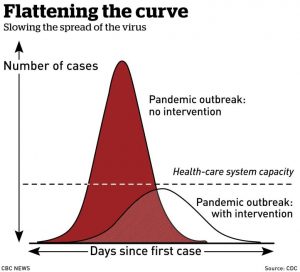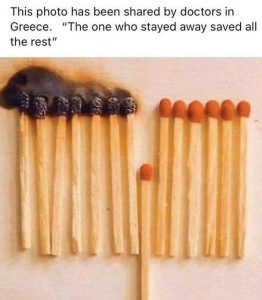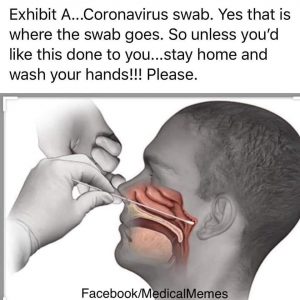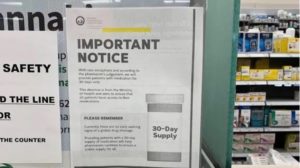There is a lot of information floating around the internet about the coronavirus. I’m not an authority on it, by any stretch, but I have been following it. With this post I am attempting to answer the most commonly asked questions that I’ve seen about the virus.
This is not a complete list of the things that we’ve seen over the past while, but it addresses the most commonly asked things. Please let me know if there is something that I’ve missed or have in error.
Please Stay Home
 The health care system in Nova Scotia has a specific capacity. We are trying to keep the virus contained so that it does not exceed that capacity. This is why we are trying to flatten the curve. This does not mean that fewer people will get sick. It does mean that fewer people will get sick at one time.
The health care system in Nova Scotia has a specific capacity. We are trying to keep the virus contained so that it does not exceed that capacity. This is why we are trying to flatten the curve. This does not mean that fewer people will get sick. It does mean that fewer people will get sick at one time.
Please help us out and stay home. This will help prevent the spread of the virus within the community.
Information Sources
You can find the latest information and statistics at the web sites below. Please refer to these web sites as the authority on the virus. There is a lot of misinformation floating around, but these contain data from as close to the source as you can get it, although it may be a few hours old.
- HRM web site – current state of HRM services
- NS Government web site – current state and statistics
- NS Government Updated Restrictions – as of May 1, 2020, this page lists those things that are re-opening
- Government of Canada web site – current state and statistics
- Johns Hopkins web site (and mobile version) – statistics
- WHO web site on the Coronavirus and the WHO dashboard
Current State
- We are under a provincial state of emergency through May 31 (this has been updated repeatedly). If you do not follow the orders of the Chief Medical Officer of Health then you can be fined and arrested. The fines are $1,000 per person per day and $7,500 per business per day. Click here for the direction from the Chief Medical Officer of Health, with updates to May 15.
- There can be no social gatherings of more than 5 people.
- Anyone who travels to Nova Scotia from anywhere, including from other provinces, must self-isolate for 14 days. Prior to March 21 it was not mandatory.
- Parks and trails are open.
- Beaches are open.
- The following activities are allowed:
- Archery
- Equestrian
- Golf
- Paddling
- Sailing / Boating
- Tennis (I am seeking clarity to see if this includes pickleball)
- Playgrounds, courts, and sports fields are closed. Click here to see the HRM web page with this information (same link as above). This HRM PSA, from May 5, provides further information.
- While the provincial order indicates that school grounds are open, HRM manages and maintains the school sports fields and courts (tennis, basketball, etc.) remain closed.
- The Met Field remains closed.
- Transit has been included as an essential service through this state of emergency. Click here for the March 26 letter from the Province.
- For the trails that are open — If you need to drive to them then they are too far away. Stay within your own neighbourhood.
- Acadia Park, including the community garden but not including the playground structure, has opened. Click here to see there Facebook message about it.
Family Bubbles are allowed
On May 15, Dr Strang announced that we are allowed to have family bubbles of two immediate family households. Families will have to figure out who is in their bubble, and the bubbles must be mutually exclusive, so large family parties are not allowed by this.
Open fire ban, but fire pits are allowed
The provincial open fire ban has been extended to June 1, although you are allowed to have fires in backyard appliances like chimeneas or fire pits.
Limiting the spread of the virus
 I’ve been very impressed with the way that Dr Strang and the NS Government has been handling this virus. The measures that we, as a municipal, provincial, and federal government have put in place are to try and limit the spread of the virus.
I’ve been very impressed with the way that Dr Strang and the NS Government has been handling this virus. The measures that we, as a municipal, provincial, and federal government have put in place are to try and limit the spread of the virus.
As of this writing, virtually all of the cases that we’ve seen are travellers returning home or within one or two steps away from those travellers. We have only seen one case that could not be explained by a being a close contact to travellers, and so that one case is being considered as community spread. We do expect more. Hopefully it will not be a lot more.
The measures that we have put in place are to limit the community spread of the virus, but it isn’t just up to the government. We also have a responsibility to help limit the spread of the virus through measures like:
- Self Isolation for 14 days – If you are sick, return home from a trip, or may have been near someone who may have the virus then you need to self isolate for 14 days. This means that you quarantine yourself, in your own home or somewhere else, and have absolutely no near physical contact with anyone. You should have groceries and other items delivered, so that you avoid stores. You can’t have friends over for coffee or dinner. You can not be in close contact with anyone. In some cases this means staying in a separate part of the same house. You are able to go outside, so long as you are not near people.
- Physical Distancing of at least 6 feet – When you do go out, whether you are in Self Isolation or not, you should be at least 6 feet away from any person. This reduces, dramatically, the possibility of the droplets reaching you. It also reminds us to not touch another person, since this virus also spreads on contact.
- No Social Gatherings of more than 5 people – This is to help limit the community spread. We have seen many places, around the planet, where there are big and small parties, where people are gathered together, where there are no protections taken. We are trying to limit or eliminate community spread before it starts, so that the virus doesn’t overwhelm the health care system here in Nova Scotia.
- Washing Your Hands and Not Touching Your Face – We need to wash our hands vigorously and often, using soap and warm or hot water. This will remove the virus from our hands more effectively than anything else. I saw one report that says that we touch our face, on average, about 31,000 times a day. Although I think that number is high, we certainly touch our face more often than we realize. And if we touch our face after our hands have touched something with the virus (like a door knob, a counter, or a debit machine) then we have just infected ourselves.
Our goal is to limit the virus to just those who have travelled before there has been a chance for community spread. We are going through these measures now so that we won’t have a huge problem on our hands later.
What about the Reckless Few? Who do I call?
If you see gatherings of more than 5 people then please call the police non-emergency number and let them know.
In our area the number to call is 902-490-5020.
PLEASE DO NOT CALL 911. That is reserved for emergencies, like criminal activity, fire, and emergency health issues.
Do I have the virus?
 The Government of Nova Scotia has put together a self assessment tool to help you determine if you might have the virus, and what the next steps should be. Click here to visit the web site. This assessment tool will give you a very simple survey and indicate what your next steps should be.
The Government of Nova Scotia has put together a self assessment tool to help you determine if you might have the virus, and what the next steps should be. Click here to visit the web site. This assessment tool will give you a very simple survey and indicate what your next steps should be.
Please do not visit your local hospital and ask to be tested. Hospitals will quickly be overwhelmed with this and so will tell you to call 811.
It is better to use the tool above and, if it recommends calling 811 then do so.
When you call 811 you may have to leave a message. A medical practitioner will call you back for further assessment, and will determine if you should head to a testing site.
Flattening The Curve
 Our health care system has limits. We only have a certain number of people, supplies, and equipment. Once any of those limits are reached we are at the capacity of our health care system to address COVID-19 and the rest of the needs of our health care system.
Our health care system has limits. We only have a certain number of people, supplies, and equipment. Once any of those limits are reached we are at the capacity of our health care system to address COVID-19 and the rest of the needs of our health care system.
“Flattening The Curve” is the result of us are taking effective measures, as a society, to avoid the spread of the virus. We are limiting our in-person interactions with others, which is described above. Over time this may not reduce the total number of cases, but it will mean that our health care system is able to cope with the patient load.
The Washington Post has an excellent article showing how the virus might spread. Click here to read their article. Their article shows different simulations. The most dramatic, for me, was the significant reduction in community spread when contact between people is minimized.
 A doctor has also produced a video talking about the spread of the virus, about how serious it is for all of us, and why we must help stop the spread. The video can be seen here: https://www.youtube.com/watch?v=edEr3-FnPbw
A doctor has also produced a video talking about the spread of the virus, about how serious it is for all of us, and why we must help stop the spread. The video can be seen here: https://www.youtube.com/watch?v=edEr3-FnPbw
This is serious. We can’t stress that enough.
Prescriptions and Dispensing Fees
 I’ve received a few calls about the change in the way that prescriptions are handled. Pharmacists are now able to fill a prescription for a maximum of 30 days, instead of the 90 days that they used to fill prescriptions for. This means that dispensing fees are being paid more often.
I’ve received a few calls about the change in the way that prescriptions are handled. Pharmacists are now able to fill a prescription for a maximum of 30 days, instead of the 90 days that they used to fill prescriptions for. This means that dispensing fees are being paid more often.
The CBC has recently published a story on this, which you can see by clicking here.
The bottom line is that this is something that has been mandated by the government. Certain pharmacies are willing to make exceptions for the number of days that you will e able to fill a prescription for, but this is on a case by case basis.
Beware of False Information
This isn’t just true of COVID-19, rather it is true about everything. We need to make sure that we look at everything with a critical eye.
- Are there miracle cures? Maybe, but not likely.
- What about Hydroxychloroquine? This is an anti-malarial drug that is currently undergoing testing for effectiveness against COVID-19. As of this writing it has not been approved by the FDA or the WHO to be used against COVID-19.
- Does a cough mean that you have the virus? Probably not, but check out the
 NS Government site, above, and if the self evaluation warrants it then call 811.
NS Government site, above, and if the self evaluation warrants it then call 811. - Can you pass along the virus even if you show no symptoms? Yes. This means to be very careful and limit your contact with others.
- Will the effects of this virus be over quickly? Not likely. If we are diligent about self isolation, social distancing, and washing our hands then it will help.
- Does it affect seniors only? NO. The graph on the right, from the Government of Canada site, shows that many younger people have gotten infected as well.
- Do we know enough about this virus? No. We are learning more and more all the time, but the world has only seen this virus for a few months.
- Toilet paper helps, right? Gosh, no. I have absolutely no idea where this started. Fortunately it seems to have run its course. What it speaks to, though, is that we need to avoid panic.
Introduction Of The Virus
 Although this virus has was identified in Dec 2019, it attracted a number of questions with articles like this: https://www.businessinsider.in/science/health/news/fighting-wuhan-coronavirus-pictures-show-how-china-built-a-1000-bed-hospital-in-10-days/articleshow/73758306.cms, which was published on January 30, a little less than 2 months ago.
Although this virus has was identified in Dec 2019, it attracted a number of questions with articles like this: https://www.businessinsider.in/science/health/news/fighting-wuhan-coronavirus-pictures-show-how-china-built-a-1000-bed-hospital-in-10-days/articleshow/73758306.cms, which was published on January 30, a little less than 2 months ago.
Since then it has more and more become a part of our conversations and had a direct impact on our daily lives.
China built a total of 16 of these hospitals and, over the past couple of months, has also done a good job of getting control of the virus. It was recently reported that China has finally seen a day where there are no new cases; where all of the cases have been discharged from these temporary hospitals and, as this article from March 11 states, all 16 of the temporary hospitals have closed.
